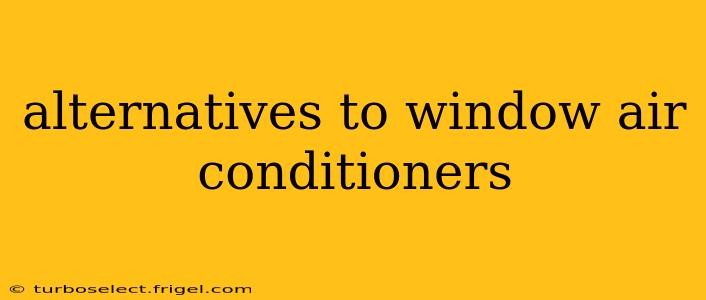Window air conditioners have long been a staple for beating the heat, but they're not the only option, and they certainly aren't ideal for everyone. Their bulky size, unsightly appearance, and sometimes noisy operation lead many to seek alternatives. This comprehensive guide explores various ways to stay cool and comfortable without relying on a window AC unit. We'll delve into different cooling solutions, considering factors like budget, energy efficiency, and environmental impact.
What are the Downsides of Window Air Conditioners?
Before we dive into alternatives, let's quickly address why people look for alternatives to window air conditioners in the first place. Many find them:
- Unsightly: They can detract from the aesthetic appeal of a window, especially in older or historically significant buildings.
- Bulky and inconvenient: Installation and removal can be a hassle, requiring effort and possibly some tools.
- Energy-intensive: They can significantly increase your electricity bill, particularly during extended periods of hot weather.
- Noisy: Some models can be quite loud, disrupting sleep and quiet time.
- Reduced window security: The presence of the AC unit can compromise window security.
Portable Air Conditioners: A Convenient Alternative?
Portable air conditioners offer a more flexible cooling solution compared to window units. They don't require installation, and can be moved from room to room as needed. However, they usually have a vent hose that needs to be placed in a nearby window or door to expel hot air, negating some of the convenience. Furthermore, they are often less energy-efficient than window units and can be noisy.
Are portable air conditioners less efficient than window units?
Yes, generally speaking, portable air conditioners are less energy-efficient than window units. This is because they need to work harder to expel the hot air, and the venting process itself can lead to energy loss.
Evaporative Coolers (Swamp Coolers): A Budget-Friendly Choice
Evaporative coolers, or swamp coolers, are a much more energy-efficient alternative, particularly in dry climates. They work by evaporating water, which cools the surrounding air. They are significantly cheaper to run than air conditioners but are less effective in humid environments.
How effective are swamp coolers in humid climates?
Swamp coolers are not effective in humid climates. The principle of evaporative cooling relies on the ability of water to evaporate quickly. High humidity reduces the rate of evaporation, making swamp coolers ineffective in humid areas.
Ceiling Fans: A Simple and Energy-Efficient Solution
Ceiling fans are a classic and energy-efficient way to stay cool. They don't actually cool the air, but they circulate it, creating a wind-chill effect that makes you feel cooler. Coupled with other strategies, ceiling fans can significantly improve comfort levels.
Do ceiling fans reduce the energy needed for air conditioning?
Yes, by effectively circulating air, ceiling fans can allow you to raise the thermostat setting on your air conditioner (if you have one) while still maintaining comfort. This leads to reduced energy consumption and lower bills.
Whole-House Fans: Cooling the Entire Home
Whole-house fans are a great solution for cooler climates or nights where outside air is significantly cooler than inside. They draw air from outside the home and expel warm air, creating a cooling effect throughout the entire house. They are very energy efficient but are not a solution for hot, humid days.
Are whole house fans good for humid climates?
No, whole-house fans are not ideal for humid climates. They will draw in humid air, defeating the purpose of cooling the house.
Other Cooling Strategies: Maximizing Natural Cooling
Several other strategies can significantly improve comfort and reduce the need for air conditioning, or can be used in conjunction with other cooling options:
- Proper insulation and ventilation: Ensure your home is well-insulated to prevent heat from entering and allow for good ventilation to remove warm air.
- Strategic window coverings: Use blinds, curtains, or awnings to block sunlight and reduce solar heat gain.
- Smart thermostats: Utilize smart thermostats to optimize cooling schedules and energy usage.
- Heat-reflecting paints: These paints can reflect sunlight and reduce the amount of heat absorbed by your home's exterior.
- Landscaping: Strategic planting of trees and shrubs can provide shade and reduce solar heat gain.
Choosing the best alternative to a window air conditioner depends on your specific needs, climate, budget, and preferences. By considering the options outlined above and employing energy-saving strategies, you can find a solution that keeps you comfortable and cool without the drawbacks of a traditional window air conditioner.
